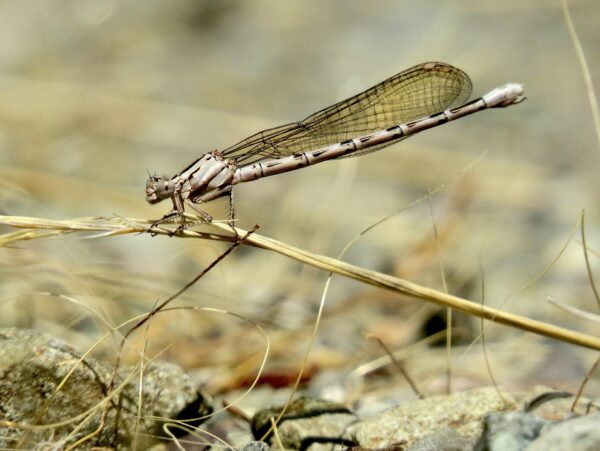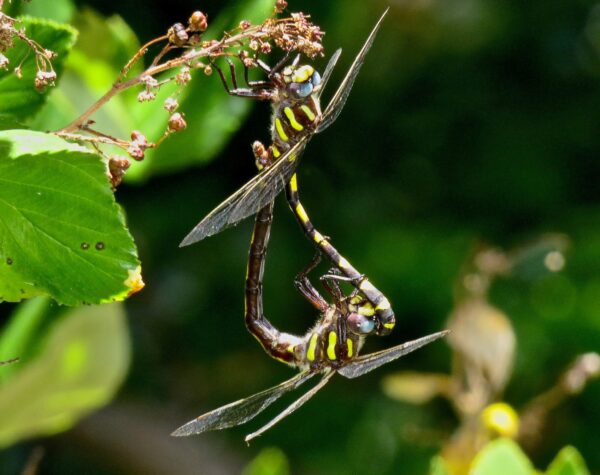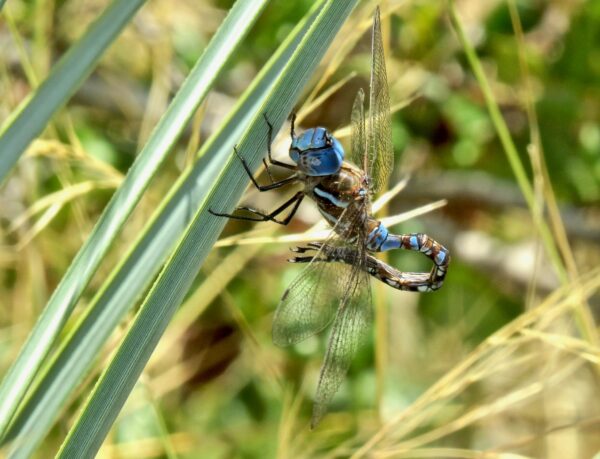
Jan O. Washburn, Entomologist & Garden Volunteer
Sarab Seth, Photographer & Garden Volunteer
Dragonflies and damselflies are conspicuous insects that can be seen in the Garden throughout much of the year. These insects (Order Odonata) have been living on earth virtually unchanged for over 300,000,000 years and were one of the first insects to take to the air. Though the two groups are closely related, dragonflies are generally much larger than damselflies and at rest hold their four, glassy wings stretched horizontally away from the body. Those that dwell in the Garden are superb and fast fliers. In contrast, damselflies are much smaller with slender bodies and are weak fliers compared to dragonflies; at rest their wings are folded together above the body along the length of the abdomen. Males of both damselflies and dragonflies are often more brightly colored than their female counterparts.

Blue-eyed Darner (Rhionaeschna multicolor), male dragonfly

Vivid Dancer (Argia vivida), female damselfly
Both immature and adult Odonata are voracious predators. Nymphs develop in aquatic habitats such as the Japanese Pool, Aquatic Plant Display, and Strawberry Creek. Some species prefer the still water of lakes and ponds, while others develop in streams and creeks. The nymphs feed on all manner of organisms including aquatic insects, newt larvae, tadpoles, and even others of their own kind. At the completion of the nymphal stages, the insects climb out of the water, typically onto emergent vegetation or rocks. This transition from an aquatic to terrestrial habitat is the last time the insect will walk. Once the adult emerges and takes flight, it is fully an aerial creature; it can only perch and is no longer capable of walking.
Adult dragonflies and damselflies can be seen throughout much of the year in the Garden. During the warmer months, adult dragonflies are common at the Japanese Pool where they can be seen patrolling their territories, hunting aerial prey, and seeking mates. Damselflies are more abundant than dragonflies, and can often be seen flying in tandem with the brightly colored male grasping the female’s head with the tip of his abdomen. These are mated pairs, and the male is guiding the female to places where she can lay eggs.

Pacific Spiketails (Cordulegaster dorsalis), mating. During mating, the female receives the sperm from the second abdominal segment.

Blue-eyed Darner transferring sperm from his genital opening for sperm at the ninth abdominal segment to his secondary genitalia on the second abdominal segment.
Newly-emerged dragonflies and damselflies are weak fliers and require time for their exoskeletons to harden and assume the adult coloration. Shortly after emergence, many species will disperse away from the aquatic habitat where they developed and can be seen far from water. Apart from a handful of photographs that are labeled, the dragonflies and damselflies in this album were all photographed in the California Area of the Garden in recent weeks. As fall approaches, they will return to aquatic habitats where they will mate, lay eggs, and begin the cycle anew.

Larval exuviae of Blue-eyed Darner (Rhionaeschna multicolor), at the Japanese Pool. This is the last exoskeleton shed by the dragonfly nymph, when it emerged as an adult, to fly for the first time.
View more images of Odonata in the UC Botanical Garden by Sarab here.
Featured Image: Cardinal Meadowhawk (Sympetrum illotum), male
